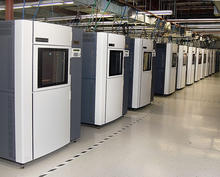Manufacturing Innovation Blog
Powered by the Manufacturing Extension Partnership

In December, I wrote about how TechSolve, part of Ohio MEP, has been helping small manufacturing firms like Morris Technologies and Rapid Quality Manufacturing that are utilizing additive manufacturing to produce components in the aerospace industry. I’ve since learned that the MEP affiliate in the Land of 10,000 Lakes, Enterprise Minnesota, is helping additive manufacturers in the aerospace industry too.
Recently, I had an opportunity to see additive manufacturing in action and up close. I was in Eden Prairie, Minnesota at the production facility of RedEye On Demand, a business unit of Stratasys. While there, I was treated to a tour of the RedEye production facility, which was quite impressive. During the tour, I saw two primary additive manufacturing techniques utilized by RedEye, including:
- Fused Deposition Modeling, or FDM, which was developed in the 1980s and commercialized in 1990 by Stratasys founder, CEO, and President S. Scott Crump. In the FDM process, a plastic filament of metal wire is unwound from a coil and supplies material to an extrusion nozzle, which can turn the flow on and off. The nozzle is heated to melt the material and can be moved in both horizontal and vertical directions by a numerically controlled mechanism, which is in turn controlled by computer-aided software. FDM applications include rapid prototyping as well as production of tools and components for the aerospace, automotive, electrical, marine, and medical device and equipment industries.

- Polyjet technology, which utilizes photopolymer resins similar to those used in stereo lithography (SLA). Like an inkjet printer, the Polyjet process deposits liquid plastic onto a build tray. Unlike your typical inkjet printer, however, a Polyjet printer employs high-power ultraviolet lamps on the sides of the print head that instantly cure and harden the dispensed plastic. Because the Polyjet process builds parts in very fine layers, with precision down to 0.0006 inches, it can be used to make concept models or final components that require smooth surfaces or very fine features. Polyjet technology can also make prototypes and final components for use in aerospace and other industries. To better understand FDM check out this video.
So, where does Enterprise Minnesota come into this equation? Well, thanks to Enterprise Minnesota, RedEye received its AS9100 Certification in December 2011. AS9100 is a widely adopted and standardized quality management system for the aerospace industry that was released in 1999 by the Society of Automotive Engineers (SAE) and the European Association of Aerospace Industries (AECMA). Major aerospace manufacturers and suppliers worldwide require compliance and/or registration to AS9100 as a condition of doing business with them.
Between 2010 and 2011, RedEye nearly doubled its sales to the aerospace market. Now, with assistance from Enterprise Minnesota and AS9100 Certification under its belt, RedEye is expecting 30-40 percent sales growth in 2013. And, oh by the way, Enterprise Minnesota also helped RedEye to become ISO 9001:2008 Certified in 2011.
As I learn more about the work of the MEP centers in helping companies using additive manufacturing, I am very excited about the possibilities the technology offers. In fact, the NIST MEP Program Development Office has recently formed an Additive Manufacturing Team that is exploring how we may support MEP Centers and their manufacturing clients with additive manufacturing needs and opportunities in prototyping, tooling, and final production. Please stay tuned for further developments!
About the author
Related Posts
Comments
- Reply


